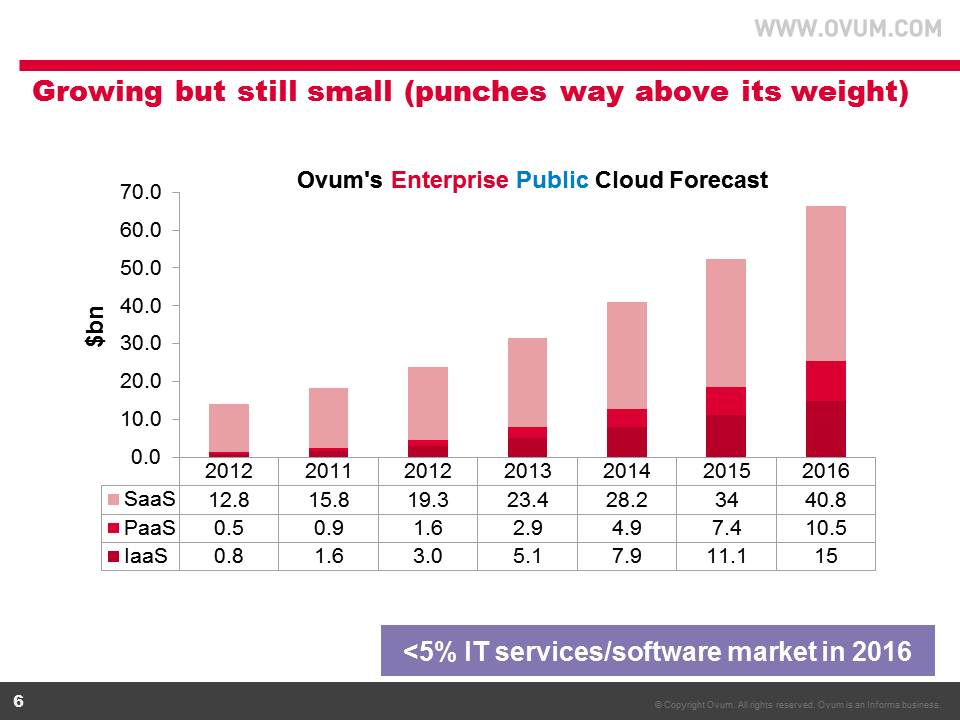I had the chance to meet with Laurent Lachal, a trained historian and technology enthusiast who has been an analyst for the English firm Ovum for 20 years. Lachal's view of the cloud computing scene is driven by insight and a clear understanding of the evolution of this new discipline, which is not just technological, but also encompasses a very strong cultural shift for enterprises that embrace it.
This interview is divided into three parts: part number one describes Lachal's vision of the cloud computing market, part two is dedicated to the two pillars of the cloud computing cultural shift i.e. empowerment and convergence, and lastly, Laurent Lachal will focus on the increasing significance of telecoms providers in that market and how they are playing an increasingly important role, namely in providing infrastructure for the cloud (IaaS).

I have been an industry analyst for 21 years, working for Ovum for 20 years and Gartner for one year. I specialised in many things over the years, the last two areas I covered for Ovum were open source and then cloud computing. Unlike most of my colleagues who are focusing on a particular market segment like ERPs or business intelligence, I tend to look at things that spread across market segments.
I started in 2010, and the first thing I did when I started working on cloud computing was to try and understand how it had evolved. I've been trained as an historian, so it came naturally to me to look at how things are changing over the years, and what I realised is that the concept of cloud computing had moved rapidly from being synonymous with infrastructure as a service, and platform as a service in 2006-2008, to synonymous with public cloud in 2008-2010, when infrastructure as a service and platform as a service combined with Software as a Service; then it all moved into hybrid cloud territory just before the notion of public cloud clashed with that of private cloud and then combined with.
There are loads of different hybrids; just in terms of private cloud for instance you have:
- hosted private cloud, when your infrastructure is not in-house,
- shared private cloud,
- virtual private club, which is a private cloud on top of a private club,
- hybrids of hybrids,
- shared virtual private clouds,
- hybrids of traditional IT services and cloud such as managed private cloud etc.
Now, you have a new generation (2012 2013) of concepts such as data cloud which is cloud computing which converges with big data, personal cloud, which is where cloud computing converges with bring your own device (BYOD), bring your own application etc.
Ovum’s depiction of the increasingly complex cloud computing environment
The market is coalescing around the notion of cloud computing and becoming much more complex. We have this notion of cloud brokers, cloud marketplace, cloud federations, which are all a reflection of this increasing complexity of the cloud computing ecosystem.
When it comes to what portion of cloud computing is most prominent, Software as a Service (SaaS) nowadays is the most prominent one, mostly because it predates cloud computing. It combined with it about 5-6 years ago, but if you look at salesforce.com, they were created at the end of 1999 and their first service was launched in February 2000. Obviously, it's much bigger now because it's older! It’s had the time to grow and it has become mainstream in the sense that most enterprises now use SaaS somewhere in their IT architecture.
Infrastructure as a Service, for a long time, had been the new kid on the block. It was there when cloud computing started and it is something which definitely caught the attention of developers. From my point of view, service providers who started with IaaS got it right from the start; others, by betting on Platform as a Service have found it much more difficult to serve the market because on the one hand it makes things easier, and on the other hand it does abstract developers from a lot of underlying things, and developers by definition, like to tinker. They don't like to be abstracted, they are hands-on, they like to be in control.
The expectation of the market now, is that Infrastructure as a Service is now well understood, and that the next wave as far as cloud computing is concerned, is about Platform as a Service. But the message available currently is that it will take at least two more years for the market to move from asking itself what it can really do with it to embracing it.

the cloud computing marketing, punching way above its weight
Ovum produced a report at the end of 2011, vis-à-vis the enterprise cloud market, without taking into account the consumer and private cloud markets, because the notion of private cloud is far too nebulous. It's very difficult to issue a forecast on that concept. It's much easier to define the boundaries of the public cloud market. What we said is that the enterprise public cloud market will grow from about $30 billion this year to about $65 billion in 2016; but even in 2016, $65 billion will amount to less than 5% of the entire service and software market. That doesn't include the consumer market not private cloud, as I mentioned above, but it kind of helps put things in context. There are two things I can add to that:
- The first thing is that cloud computing punches way above its weight when it comes to market influence. What it means is that what matters with cloud computing is not cloud computing itself, but what you do with it! And an increasing number of businesses, as well as an increasing number of applications run on cloud platforms of any kind. Whilst the market for cloud computing itself is relatively small, what one does on top of it is increasingly significant.
- Secondly, this isn’t a black-and-white situation: with this notion of hybrid, things are getting increasingly “cloudified”. IT services, for instance are increasingly available on demand, through cloud service portals. IT services managed hosting, for instance are increasingly integrated with cloud services: the same contract, same portal etc.
So it's more and more difficult to slice that particular cake specifically, but this notion of $65 billion in 2016 is a nice reminder to keep things in context.
Yann
Read the whole interview:
- Part One: cloud computing evolution explained by a trained historian
- Part Two: the cloud computing cultural shift, fuelled by convergence & empowerment
- Part Tree: telco operators at the heart of the cloud computing revolution
This blog post was originally published in French here.
crédit photo : © milka-kotka - Fotolia.com

I specialize in information systems, HighTech marketing and Web marketing. I am author and contributor to numerous books and the CEO of Visionary Marketing. As such, I contribute regularly on this blog for Orange Business account on cloud computing and cloud storage topics.